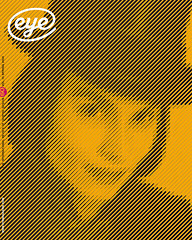Summer 2006
Marketing is not a dirty word
Letter from Rachel Marsh
Nick Bell’s articles on art gallery identity (Eye no. 59 vol. 15 and Eye no. 53 vol. 14) examine gallery branding as though it is taking place in a vacuum, which means that he is only telling half the story.
I am studying for a degree in Graphic Design and Production at the Plymouth College of Art and Design (UK). Last term, provoked by Nick Bell’s article ‘The steamroller of branding’ (Eye 53), I researched the development of the brand identity of the Whitechapel Art Gallery.
I came to the conclusion that cultural institutions are having to steer a difficult course through the following challenges:
* attracting new visitors;
* competing for funding from the Arts Council, local authorities and charities – and to be accountable for how they spend that money;
* competing for corporate sponsors – who want to get something for their money and feel that they’re supporting something ‘cool’;
* increasing the percentage of earned revenue to arts funding, when charging for exhibitions is rarely an option.
And they have to do this at a time when lottery funding has helped fund the extension of almost every gallery in London, and the building of a good many new ones – meaning even more competition for visitors, revenue funding and sponsorship.
To be honest it’s a wonder that art galleries can keep their credibility at all!
Accountability and added value are important for funders, so the Whitechapel is under pressure to follow a ‘corporate’ approach – showing evidence of business planning, a strong marketing policy and measurable outputs. This means that a ‘corporate style’ branding ethos is a necessity and not a sell-out.
Should publicly funded art galleries have a corporate brand identity? In some ways this is a ridiculous question – the Whitechapel has had a brand identity since 1969 when Richard Hollis developed a consistent – though low-cost and flexible – marketing strategy. However, the ‘brand’ has become increasingly important under the political pressure to follow a business model and appeal to corporate sponsors. The communications and the education departments at the Whitechapel are now larger than the exhibitions department. A strong and consistent brand is necessary as the gallery’s activities spill into the surrounding community with education projects and exhibitions that take place across the East End.
Gallery identity design used to be the preserve of the section of British graphic design that stood for putting communication and creative freedom before corporate strategy – people like the signatories of the First things first 2000 manifesto, e.g. Nick Bell. I believe that is the graphic design culture with which Richard Hollis, Peter Saville and Kate Stephens (all former designers at the Whitechapel) would be most comfortable. But now Wolff Olins, the corporate branding giants – who as Rick Poynor puts it ‘see design primarily as a business and subordinate creative goals to the imperatives of commerce’ – have moved on to the scene with their work at Tate, and other galleries are being challenged to keep up.
This is only a problem if the marketing gurus take over, and the real voice of the gallery is lost. After all, a brand is more than a logo, and if the brand promises something it can’t deliver and the exhibitions are rubbish, then no one will take any notice. Fortunately, evidence at the Whitechapel suggests that the gallery is very much in control. Its latest identity created by Spin has subtly changed since 2003, bringing the design ethos closer to that of Richard Hollis and further from the original type-heavy concept that Nick Bell criticised in 2004. Creative agencies such as Spin are carving a middle-ground between the two cultures of British graphic design by creating identities that serve commercial imperatives while keeping a fresh experimental approach. Nick Bell needn’t worry: the Whitechapel identity has proved that there is still room to let the art talk.
Plymouth
First published in Eye no. 60 vol. 15 2006
Eye is the world’s most beautiful and collectable graphic design journal, published quarterly for professional designers, students and anyone interested in critical, informed writing about graphic design and visual culture. It is available from all good design bookshops and online at the Eye shop, where you can buy subscriptions, back issues and single copies of the latest issue. You can also browse visual samples of recent issues at Eye before You Buy.

